Choosing the right bike size is paramount for comfort, efficiency, and injury prevention when cycling. Whether you’re buying a new bike online, assessing a used one, or simply trying to understand your current ride better, knowing how to measure a bike frame is an invaluable skill. Bike manufacturers use various sizing conventions, which can sometimes be confusing. Understanding the key frame measurements allows you to compare bikes accurately and ensure you get the perfect fit.
This guide will walk you through the essential measurements you need to take to determine the size of a bike frame. We’ll break down each component and explain how to measure it accurately, so you can confidently choose a bike that fits you like a glove.
Key Bike Geometry Measurements Explained
Before we dive into the ‘how-to’, let’s quickly define the crucial bike geometry measurements you’ll be working with. These measurements provide a comprehensive picture of a bike’s size and riding characteristics.
- Top Tube Length (Effective): This is the horizontal distance from the center of the head tube to the center of the seat post. It’s a critical factor in determining the bike’s reach and overall riding position.
- Seat Tube Length: Measured from the center of the bottom bracket to the top of the seat tube, this measurement traditionally indicated frame size, though less relevant now due to varying frame designs.
- Reach: The horizontal distance from the bottom bracket to the top of the head tube. Reach is a key indicator of how stretched out you’ll be on the bike.
- Stack: The vertical distance from the bottom bracket to the top of the head tube. Stack height influences how upright or aggressive your riding posture will be.
- Wheelbase: The distance between the front and rear wheel axles. Wheelbase affects stability and handling; longer wheelbases generally offer more stability.
- Chainstay Length: The distance from the center of the bottom bracket to the rear axle. Chainstay length influences how quickly a bike accelerates and handles; shorter chainstays often mean quicker handling.
- Front Center: The distance from the center of the bottom bracket to the front axle. Along with chainstay length, it determines the wheelbase and impacts weight distribution and handling.
- Seat Tube Angle: The angle of the seat tube relative to the ground. This angle affects your hip angle and pedaling efficiency.
- Head Tube Angle: The angle of the head tube relative to the ground. Head tube angle influences steering responsiveness and stability.
- Bottom Bracket Drop: The vertical distance between the wheel axles and the bottom bracket. Bottom bracket drop affects stability and cornering ability.
- Bottom Bracket Height: The vertical distance from the ground to the bottom bracket. Bottom bracket height influences ground clearance and center of gravity.
Tools You’ll Need for Measuring Your Bike Frame
To accurately measure your bike frame, gather these essential tools:
- Tape Measure: A standard tape measure, preferably metric for consistency, will be your primary tool for measuring lengths.
- Clinometer (or Smartphone App): A clinometer measures angles. Many free smartphone apps are available that perform this function accurately.
- Spirit Level (or Straight Edge with Clinometer App): A long spirit level ensures horizontal and vertical measurements. Alternatively, use a straight piece of wood combined with your clinometer app.
- Plumb Line (or String and Weight): A plumb line helps establish a vertical reference. You can improvise with string and a small weight like Blu Tack or a nut.
While metric measurements are standard in the cycling industry, some manufacturers, particularly for mountain bikes, might still use inches. For consistency, we recommend sticking to metric units (centimeters). If necessary, you can convert centimeters to inches by dividing by 2.54.
For current bike models, manufacturer websites often provide detailed geometry charts. If your bike is a recent model, checking the official geometry chart is advisable as it offers precise measurements and can be a useful reference.
Step-by-Step Guide to Measuring Top Tube Length
 Top tube measurement demonstrated on a bike frame
Top tube measurement demonstrated on a bike frame
Alt text: Measuring effective top tube length on a bicycle frame, showing the horizontal distance from the head tube to the seat post.
Historically, bike frames featured horizontal top tubes. Modern bike designs often incorporate sloping top tubes. When assessing bike geometry, the effective top tube length (or virtual top tube length) is crucial. This measurement provides a standardized horizontal length, regardless of the top tube’s slope.
To measure the effective top tube length:
- Identify the center of the head tube and the center of the seat post.
- Use your spirit level (or clinometer app and straight edge) to ensure a perfectly horizontal line between these two points.
- Measure the horizontal distance between the head tube centerline and the seat post centerline. This is your effective top tube length.
Manufacturers often use top tube length to size road bikes. However, mountain bikes and some road bikes commonly use S, M, L sizing. Be aware that sizing can vary between brands. A size S frame from one brand may have a top tube length equivalent to a size M from another. Also, different brands might have slightly varying methods for measuring virtual top tube length.
Measuring Seat Tube Length Accurately
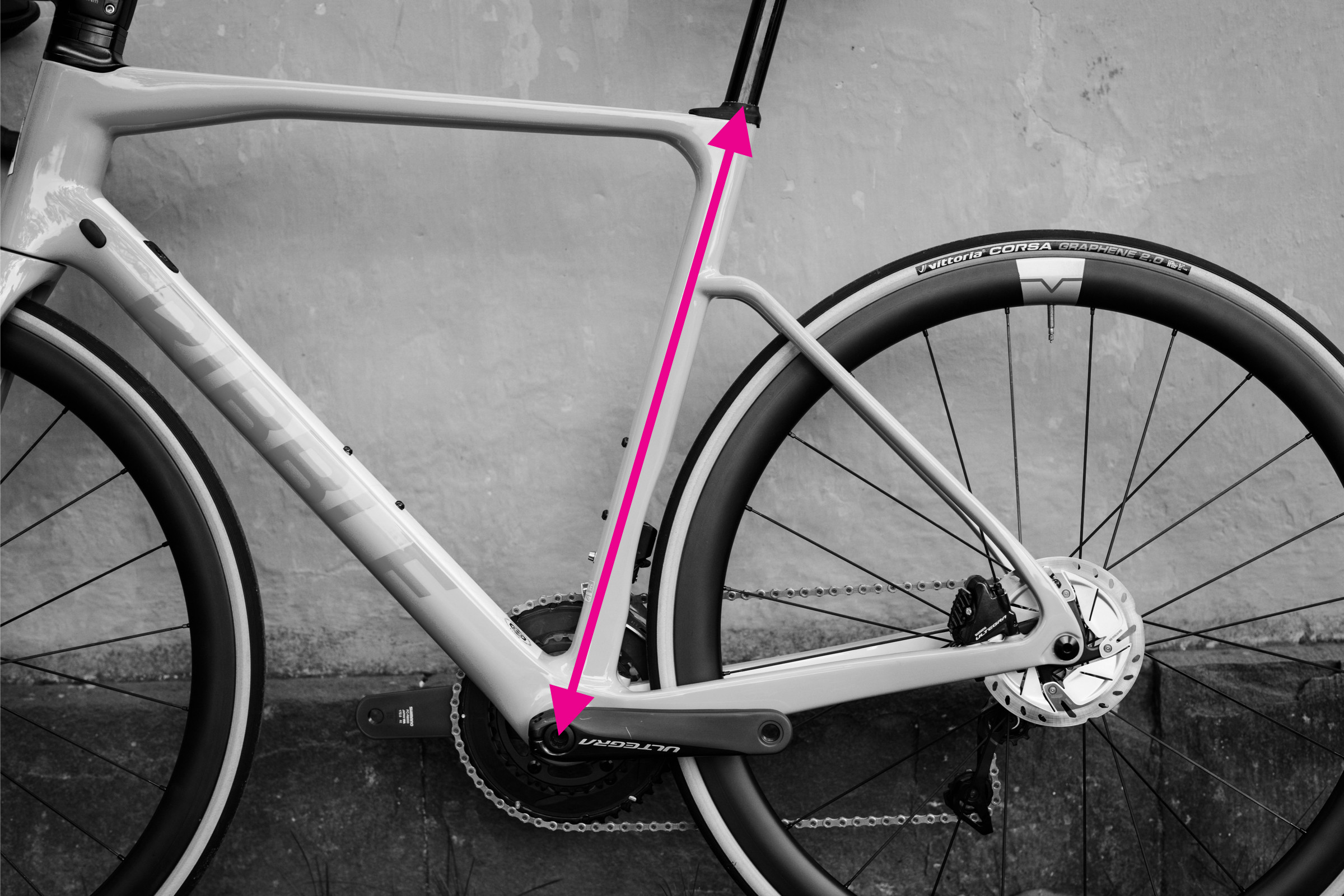 Seat tube measurement demonstrated on a bicycle frame
Seat tube measurement demonstrated on a bicycle frame
Alt text: Illustration of seat tube measurement on a bicycle frame, indicating the straight-line distance from the bottom bracket center to the top of the seat tube.
Seat tube length is measured as the straight-line distance from the center of the bottom bracket to the top of the seat tube. However, frame designs can complicate this measurement:
- Some bikes, like the Trek Madone, feature seat tubes that extend significantly above the top tube junction.
- Others use seat masts, making direct comparisons challenging.
- Mountain bikes often have kinks or bends in the seat tube.
To measure seat tube length accurately:
- Locate the center of the bottom bracket.
- Identify the top of the seat tube.
- Align your straight edge from the bottom bracket center to the top of the seat tube, disregarding any bends in the tube itself.
- Measure the straight-line distance along this line. This is your seat tube length.
How to Measure Reach and Stack for Bike Fit
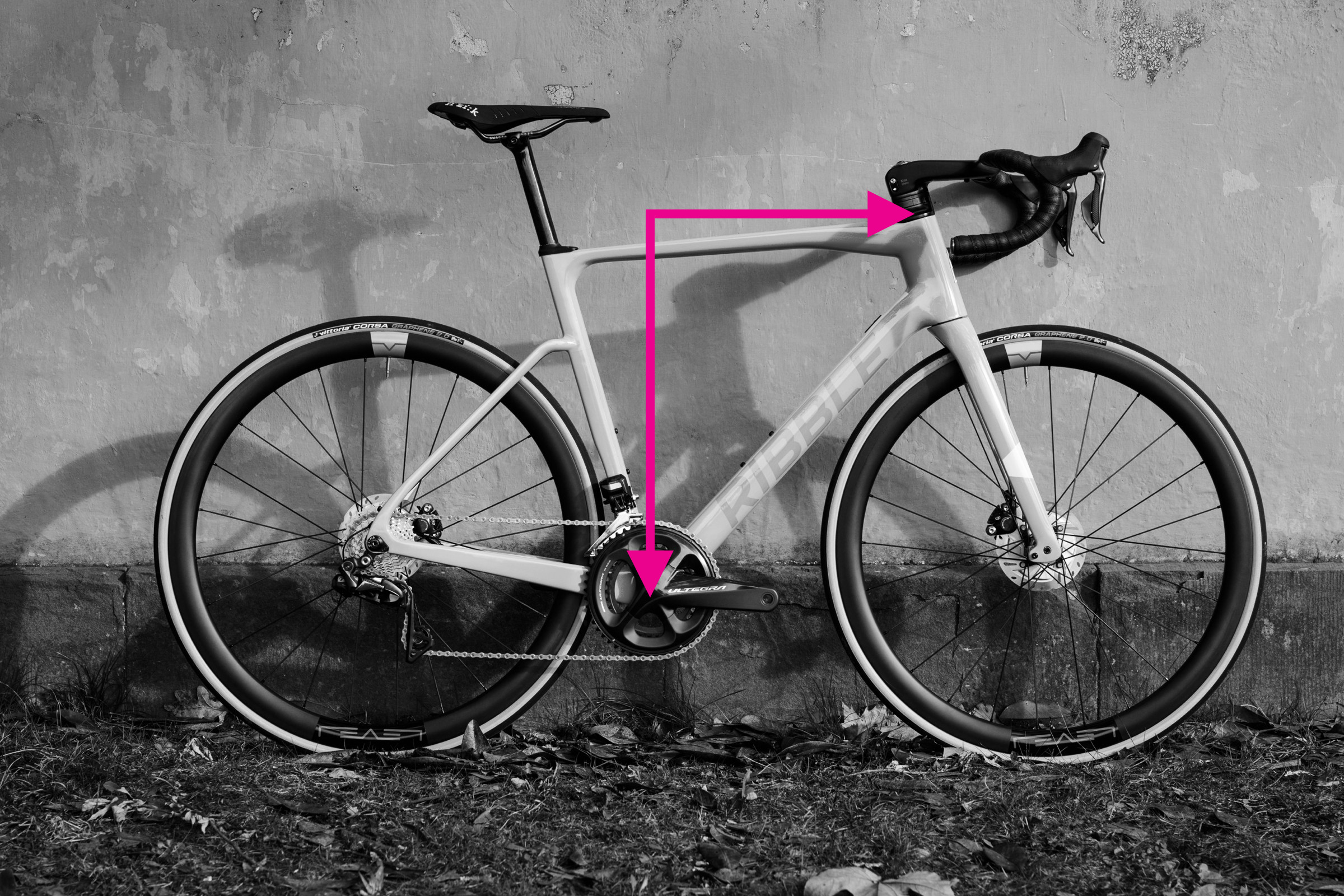 Stack and reach measurement demonstrated on a bike frame
Stack and reach measurement demonstrated on a bike frame
Alt text: Diagram showing stack and reach measurements on a bicycle frame as perpendicular distances from the bottom bracket to the head tube top.
Reach and stack provide more consistent and comparable measurements between different bike frames, as they are independent of traditional frame geometry. They measure the perpendicular distances between the bottom bracket and the top of the head tube, two critical contact points on a bike.
Reach is the horizontal distance. To measure it:
- Align your spirit level with the top of the head tube center.
- Attach a plumb line to the level’s edge, ensuring it hangs straight from a secure, symmetric weight.
- Adjust the level until the plumb line intersects precisely with the center of the bottom bracket spindle.
- Measure the horizontal distance from the top of the plumb line to the center of the head tube. This is your reach.
Stack is the vertical distance. Once you have the setup for reach measurement:
- Maintain the plumb line position intersecting the bottom bracket center.
- Measure the vertical distance from the bottom bracket center (along the plumb line) up to the level aligned with the top of the head tube. This is your stack.
Alternatively, for stack, measure the vertical distance from the ground to the top of the head tube and then subtract the height of the bottom bracket from the ground.
Reach and stack measurements can be tricky and might require a second person to assist. Repeating the measurements a few times ensures accuracy and consistency.
Measuring Wheelbase for Ride Quality Assessment
 Wheelbase measurement demonstrated on a bike frame
Wheelbase measurement demonstrated on a bike frame
Alt text: Wheelbase measurement on a bicycle, illustrating the distance between the front and rear axle centers for assessing ride stability.
Wheelbase, the distance between the front and rear axles, is a key factor in a bike’s ride quality and varies with frame size. A longer wheelbase generally results in a more stable ride.
To measure wheelbase:
- Ensure the front fork is pointing straight ahead. Misalignment will lead to inaccurate measurements.
- Measure the distance between the front and rear axle centers.
- Repeat the measurement on both sides of the bike and calculate the average for increased accuracy, especially if fork alignment is uncertain.
Determining Chainstay Length for Handling Characteristics
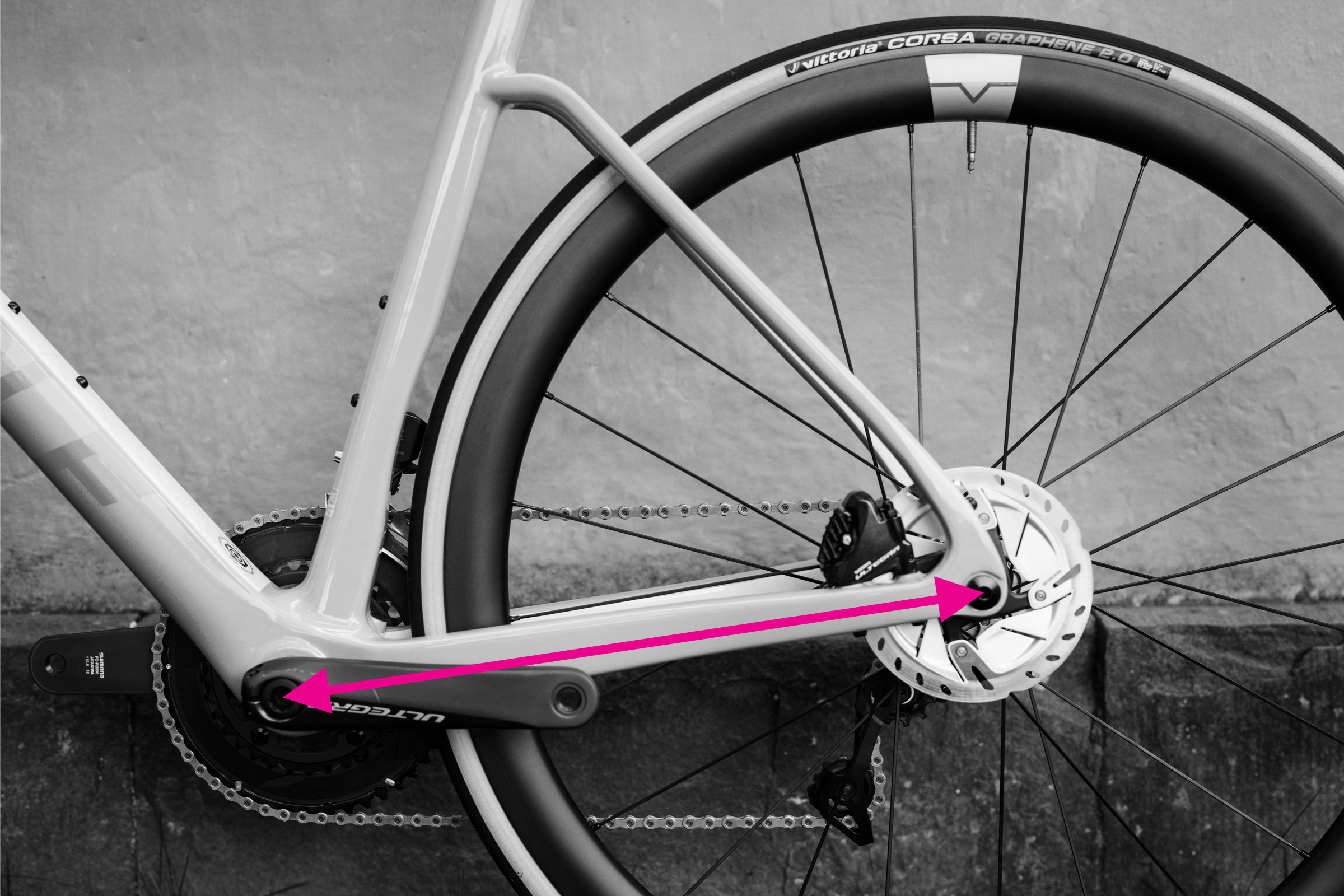 Chainstay length measurement demonstrated on a bike frame
Chainstay length measurement demonstrated on a bike frame
Alt text: Measuring chainstay length on a bicycle frame, showing the distance from the bottom bracket center to the rear dropout center, influencing bike handling.
Chainstay length, a component of wheelbase, significantly influences a bike’s handling. Shorter chainstays typically make a bike feel more agile and responsive.
To measure chainstay length:
- Locate the center of the bottom bracket axle.
- Identify the center of the rear dropout.
- Measure the straight-line distance between these two points using your tape measure. This is your chainstay length.
Measuring Front Center for Balance and Handling
 Front centre measurement demonstrated on a bike frame
Front centre measurement demonstrated on a bike frame
Alt text: Front center measurement on a bicycle, demonstrating the distance from the bottom bracket center to the front dropout center, affecting handling and toe overlap.
Front center is the counterpart to chainstay length, measured from the bottom bracket axle to the front axle. It also affects handling and influences toe overlap (how much your foot might hit the front wheel when turning).
To measure front center:
- Locate the center of the bottom bracket axle.
- Identify the center of the front dropout.
- Measure the straight-line distance between these points. This is your front center measurement.
Note that wheelbase is not simply the sum of chainstay length and front center because these measurements are not taken along a horizontal plane.
Measuring Seat Tube and Head Tube Angles
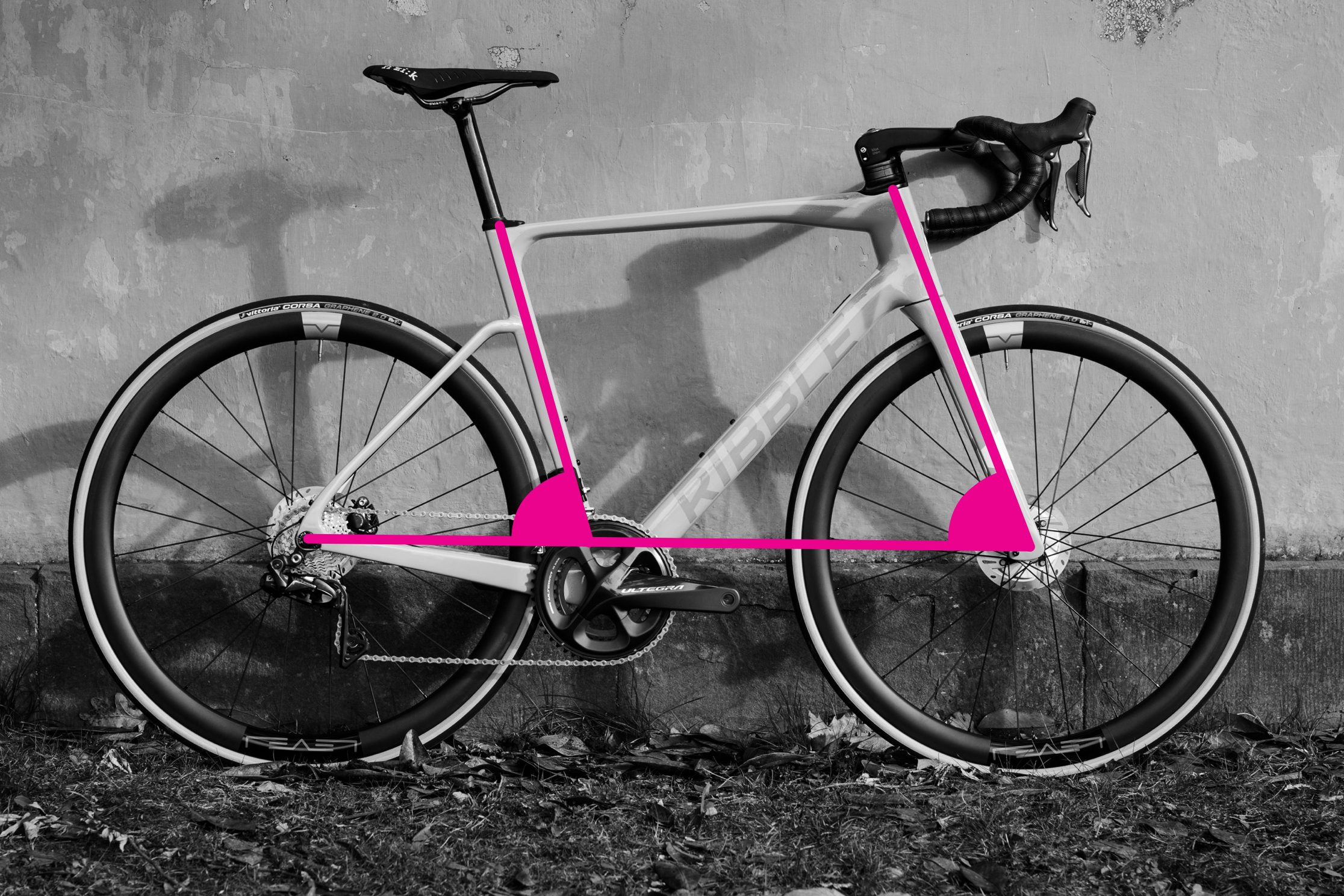 Seat and head tube measurements demonstrated on a bike frame
Seat and head tube measurements demonstrated on a bike frame
Alt text: Measuring seat tube and head tube angles on a bicycle frame using a clinometer app to determine handling characteristics.
Seat tube and head tube angles are crucial determinants of a bike’s handling. Steeper angles generally lead to quicker, more nimble handling. Use your clinometer app for these measurements.
Seat Tube Angle:
- Place your bike on a level surface and ensure it’s vertical.
- For straight seat tubes: Align your smartphone with the seat tube.
- For kinked seat tubes: Use a straight edge to create a line from the bottom bracket shell to the top of the seat tube and align your phone with the straight edge.
- Read the angle from your clinometer app.
Head Tube Angle:
- For tapered head tubes: Estimate the centerline angle by aligning your phone or straight edge with the centers of the top and bottom of the head tube.
- For straight fork legs (without crown angle): The fork leg angle will match the head tube angle. Align your phone with the fork leg.
- Alternatively, measure the angle of the steerer extension above the head tube.
- Read the angle from your clinometer app.
Ensure the bike is vertical and on level ground for accurate angle measurements.
Measuring Bottom Bracket Drop for Stability
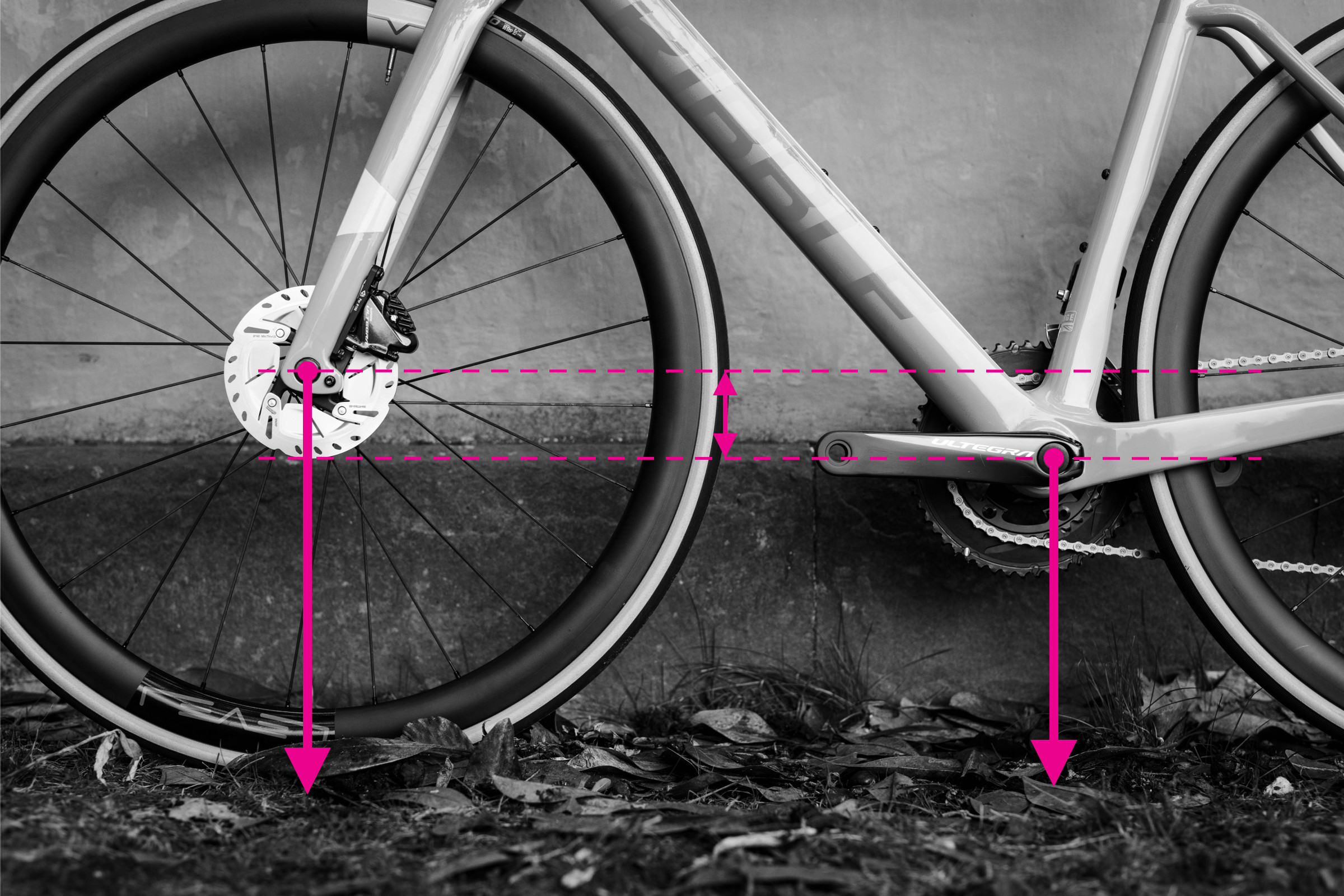 BB drop measurement demonstrated on a bike frame
BB drop measurement demonstrated on a bike frame
Alt text: Bottom bracket drop measurement on a bicycle frame, showing the vertical distance difference between wheel axles and crank axle centerline for stability assessment.
Bottom bracket drop is the vertical distance difference between the wheel axles and the centerline of the crank axle. It influences stability and cornering.
To measure bottom bracket drop:
- Measure the height of the rear axle from the ground.
- Measure the height of the bottom bracket from the ground.
- Subtract the bottom bracket height from the rear axle height. The result is your bottom bracket drop.
Measuring Bottom Bracket Height for Ground Clearance
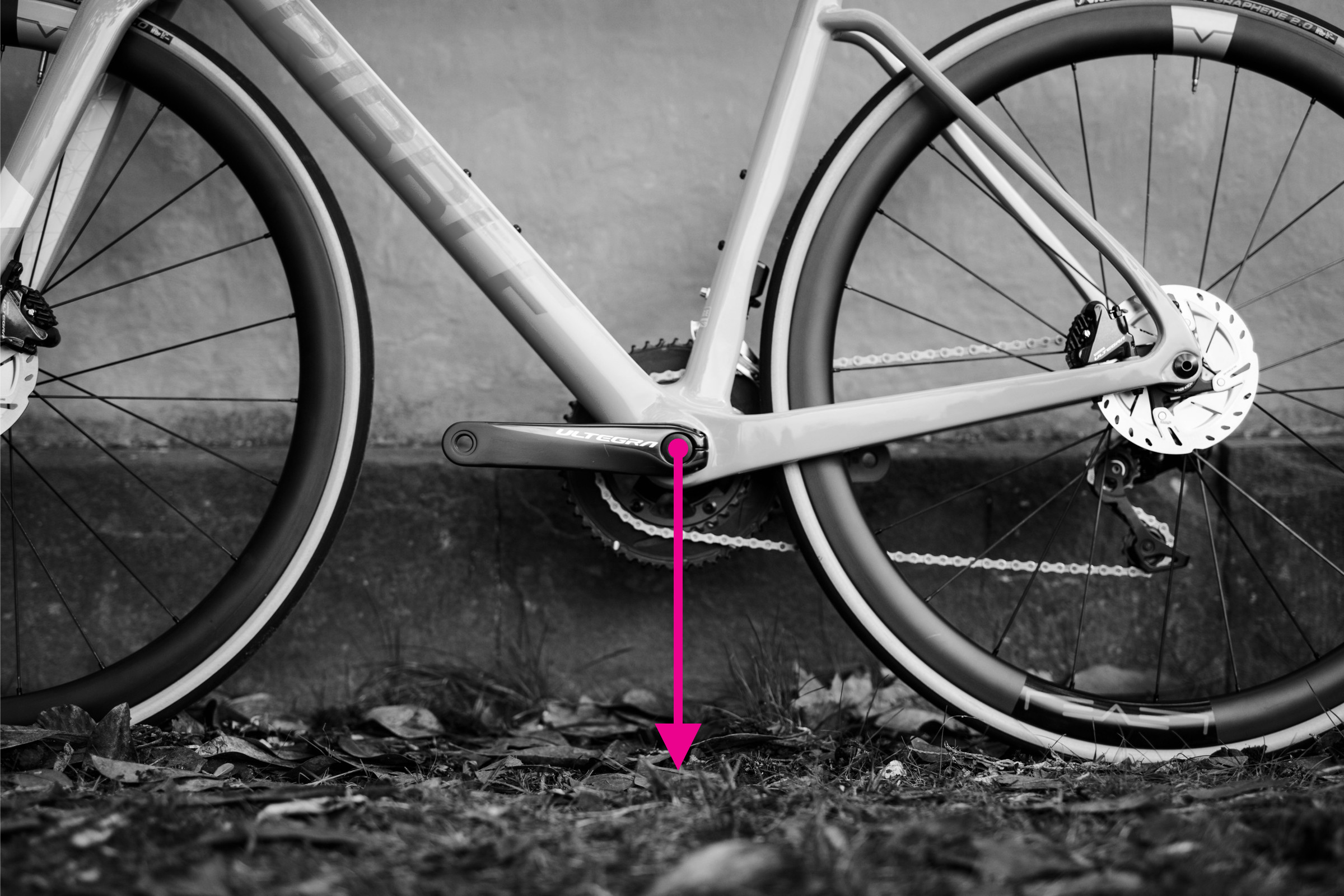 Bottom bracket height measurement demonstrated on bike frame
Bottom bracket height measurement demonstrated on bike frame
Alt text: Bottom bracket height measurement on a bicycle, illustrating the vertical distance from the ground to the bottom bracket shell for ground clearance evaluation.
Bottom bracket height is the distance from the ground to the center of the bottom bracket shell. It affects ground clearance and is relatively straightforward to measure.
To measure bottom bracket height:
- Ensure your tires are inflated to your standard riding pressure. Tire pressure can slightly affect this measurement.
- Measure the vertical distance from the ground to the center of the bottom bracket shell. This is your bottom bracket height.
By taking these comprehensive measurements, you’ll have a detailed understanding of your bike frame’s size and geometry. This knowledge is invaluable when making informed decisions about bike purchases, adjustments, and ensuring a comfortable and efficient cycling experience for years to come. Keep these measurements recorded safely for future reference.
